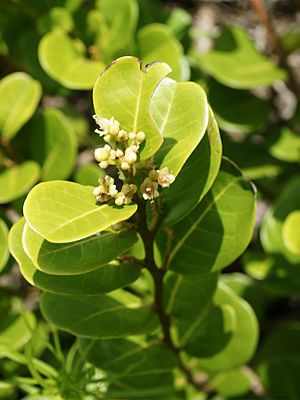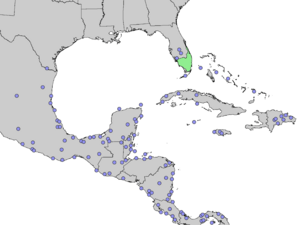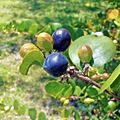Cocoplum facts for kids
Quick facts for kids Cocoplum |
|
|---|---|
 |
|
| Chrysobalanus icaco leaves and flowers | |
| Scientific classification | |
| Genus: |
Chrysobalanus
|
| Species: |
icaco
|
 |
|
| Distribution | |
| Synonyms | |
|
|
The cocoplum (also called Chrysobalanus icaco, paradise plum, abajeru, or icaco) is a cool plant found in warm, tropical places. You can spot it near sea beaches and further inland across tropical Africa, the Americas, and the Caribbean. It also grows in southern Florida and the Bahamas.
Sometimes, the cocoplum is brought to other tropical islands. There, it can grow so well that it becomes an invasive plant. This means it might take over areas where it wasn't originally found. Scientists believe there are two main types, or ecotypes, of cocoplum. One type grows near the coast, and the other grows inland. Both the ripe fruit and the seed inside are safe to eat!
Contents
What Does a Cocoplum Look Like?
The cocoplum is usually a shrub, about 1 to 3 meters (3 to 10 feet) tall. It can also grow into a bushy tree, reaching 2 to 6 meters (7 to 20 feet). Sometimes, it even grows as tall as 10 meters (33 feet)!
Its leaves stay green all year round. They are broad and oval-shaped, almost round. They feel a bit leathery and measure about 3 to 10 cm (1 to 4 inches) long. The leaves can be green or even a light red color. The bark of the cocoplum tree is usually grayish or reddish-brown with small white spots.
Flowers and Fruit
Cocoplum flowers are small and greenish-white. They grow in clusters and can appear throughout the year. However, you'll see the most flowers in late spring.
After the flowers, the plant grows a fruit called a drupe. This fruit can look different depending on where the plant grows.
- Coastal cocoplums have round fruits, up to 5 cm (2 inches) wide. They can be white, pale yellow with a pink blush, or dark purple.
- Inland cocoplums have oval fruits, up to 2.5 cm (1 inch) long. These are usually dark purple.
The fruit is edible and has a mild, slightly sweet taste. People sometimes use it to make jam. Inside the fruit, there's a brown seed with five or six ridges. This seed also has an edible white part inside. In places like Barbados, Trinidad and Tobago, and Guyana, the fruit is often called "fat pork." The seed's inner part can be ground into a powder and used as a spice in West African Pepper Soup Mix.
Where Does Cocoplum Grow?
Cocoplum plants cannot survive very cold weather or hard frosts. Because of their nice look and easy care, they are often planted as decorative shrubs in warm, subtropical areas. They can grow well in different types of soil, even in very alkaline (high pH) soil, and they don't need full sun all the time.
Special Types of Cocoplum
Plant growers have developed different types of cocoplum, called cultivars, for various uses:
- Red Tip: This type comes from the inland cocoplum. It's very popular in Florida and is often used to make hedges. Its new leaves have a pretty pink color.
- Green Tip: Another inland type, this one has new leaves that are green.
- Horizontal: This type comes from the coastal cocoplum. Its branches tend to spread out and can even grow roots where they touch the ground. This helps the plant form thick clumps over time. Because it can handle a lot of salt, the 'Horizontal' cocoplum is great for planting along beaches. It helps to hold the soil in place and stop erosion (when soil washes away).
Traditional Uses
In some parts of the world where cocoplum grows naturally, people have used it in traditional medicine. Scientists have studied the plant's leaves and found that they may have properties that could help with blood sugar levels, protect cells, and fight against fungi.
Gallery
-
Cocoplum growing in Oleta River State Park - Fruit and branches
See also
 In Spanish: Chrysobalanus icaco para niños
In Spanish: Chrysobalanus icaco para niños






